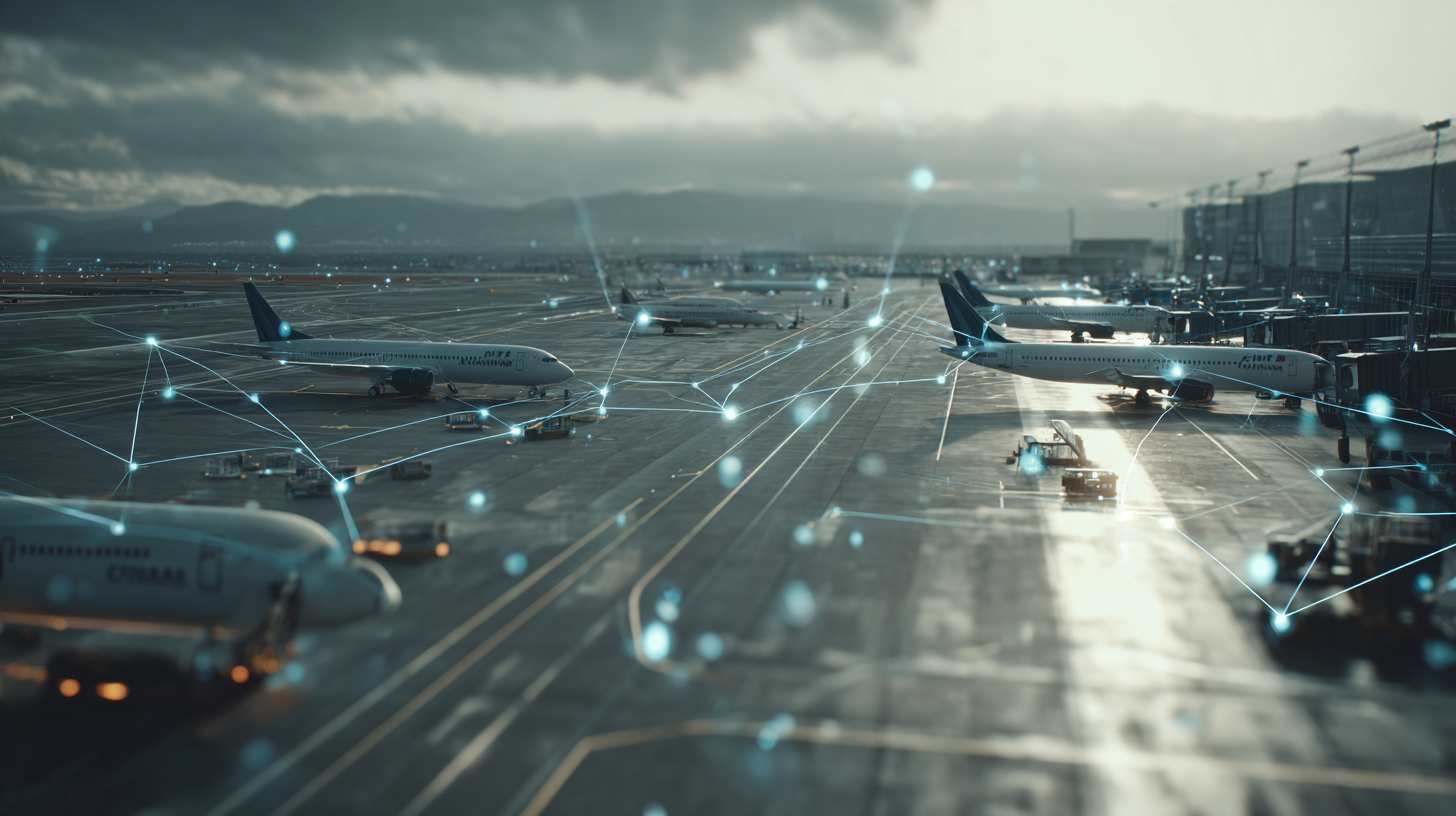AI has become the dominant innovation theme across industries, and aviation is no exception.
From investor calls to conference panels, it’s hard to find a conversation about the future of airlines that doesn’t put AI front and center.

Yet for all the buzz, there’s still a fog of uncertainty.
- What will AI actually mean for airlines, not just in five or ten years, but in the near term?
- Will it really transform operations and reshape customer experience, or remain stuck in pilot projects and press releases?
We set out to cut through the noise.
Rather than speculate about distant futures, we went searching for airlines already deploying AI with measurable impact.
The result: three carriers that stand out for their clear strategies and early execution.
In this article, we’ll showcase three AI initiatives per carrier that reveal how leading airlines are already using AI to optimize operations, reduce delays, and personalize journeys.
How we picked our AI leaders
AI is everywhere. In fact, around 8 in 10 companies worldwide now use AI in at least one core business function.
Airlines are no exception, but most of their AI experimentation happens behind closed doors.
That raised our first question: how do you actually identify the airlines leading the AI race?
We scanned across multiple signals, such as news articles, interviews, and earnings call mentions.
Out of that research, three carriers consistently stood out: Air Canada, Alaska Airlines, and Delta.

Of course, this doesn’t mean other airlines aren’t experimenting as well.
It’s very likely several are testing AI just as aggressively, if not more so.
But the three we selected share something important: they’ve been willing to talk openly about their initiatives, giving us enough detail to analyze their strategies and projects.
That transparency allowed us to connect the dots and spotlight the most concrete examples of AI adoption in the airline industry today.
Three airlines, three AI playbooks
Before we dive into the specifics of each airline’s AI projects, it’s worth stepping back.
What makes Delta, Alaska Airlines, and Air Canada so interesting isn’t just the use cases themselves; it’s how differently they’ve chosen to approach AI.
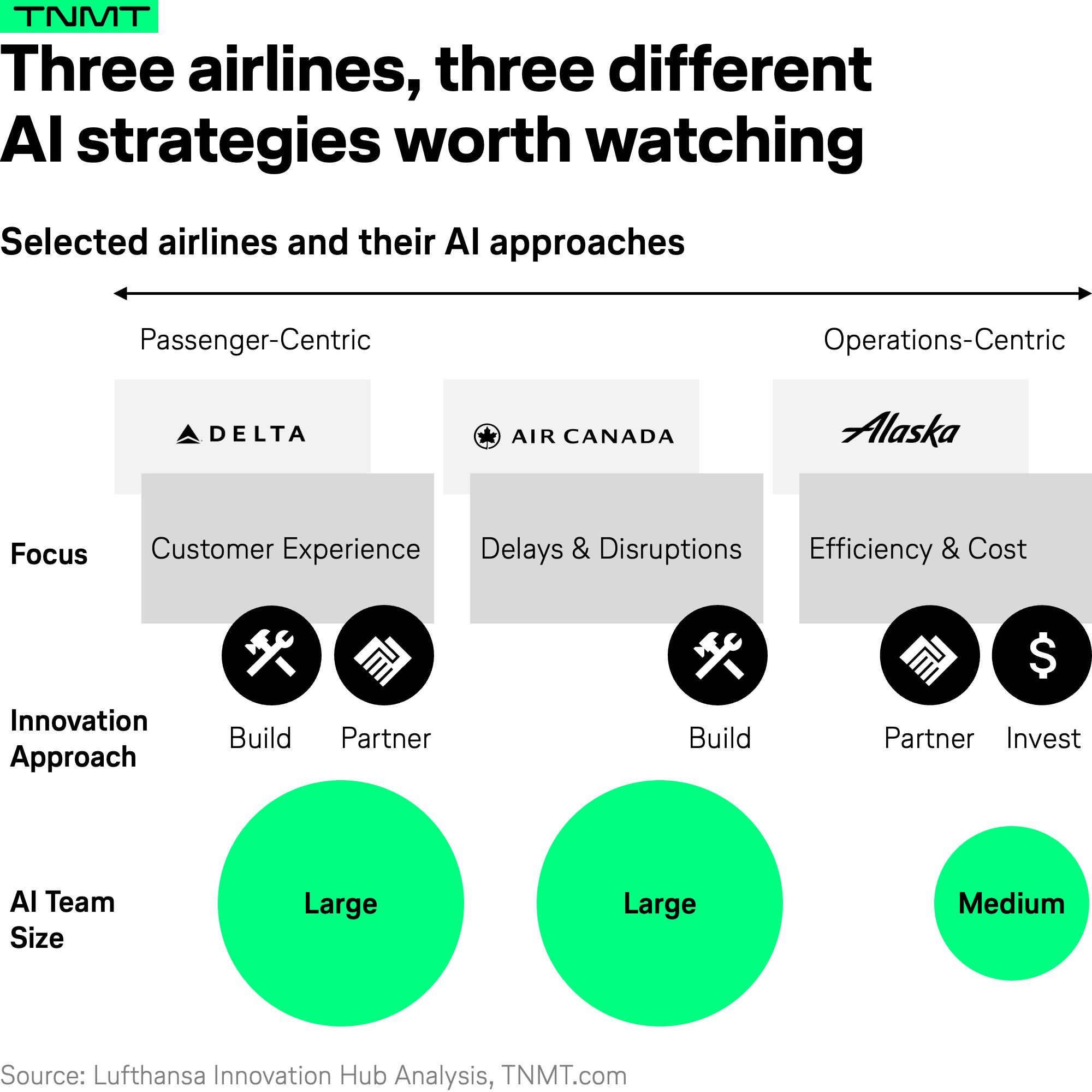
Delta has leaned heavily into the customer-facing side of the journey.
- From generative AI concierges in the Fly Delta app to continuous pricing engines, most of its AI bets are directly visible to travelers.
- The goal: reduce friction, personalize experiences, and unlock new revenue streams at the booking and travel interface.
Alaska Airlines, by contrast, has doubled down on the operational backbone of the business.
- Its biggest AI investments target flight planning, turnaround optimization, predictive maintenance, and scheduling.
- These tools aren’t necessarily visible to passengers, but they make the airline more efficient and resilient.
Air Canada sits somewhere in between.
- Its AI strategy focuses (mostly) on on-time performance and disruption management.
- This makes it largely an operational play, but one with direct passenger impact, given that delays remain travelers’ number one frustration.
The differences don’t stop at where AI is applied.
They also extend to how innovation is done.
- Delta pushes forward through a “build-or-partner” model, developing tools mostly internally or working with external tech providers.
- Air Canada relies primarily on a build-alone model, keeping AI development mostly in-house.
- Alaska Airlines embraces a more open innovation approach, partnering with startups and even investing in them through its venture arm.
We conclude: Three airlines, three strategies, three philosophies of innovation.
Together, they provide a rare window into how aviation’s AI future might unfold.
Now, let’s take a closer look at these strategies in detail, starting with Delta Airlines.
Delta Airlines: Weaving AI into the entire journey
Delta has moved from isolated AI pilots to embedding the technology across nearly every corner of the business. The aspiration, as Delta executives describe it, is to connect the journey through a “digital thread” – one that links booking, airport, in-flight, and even post-travel interactions into a seamless, personalized experience.
- This approach is unmistakably customer-centric, and by extension, revenue-focused.
- After all, revenue is earned with customers.
- So, Delta is betting that AI can both reduce friction and unlock new monetization opportunities.
Crucially, this isn’t just a tech experiment run by a small team on the side. Delta has embedded AI structurally into its organization.
- Delta built its AI governance around existing ethical frameworks (The Way We Fly and Rules of the Road) to anchor operational gains in safety, security, and trust.
- In April 2025, the airline issued formal AI Terms of Use that require disclosure whenever customers interact with AI systems.
Delta has also realized that effective AI requires more than just algorithms. It requires digital transformation at scale.
Between 2021 and 2023, the airline migrated its core systems to the cloud, modernizing its data infrastructure so that AI can now be layered cleanly on top of reservations, loyalty, and operational platforms.
Out of this broader push, three initiatives stand out as the clearest examples of Delta’s AI strategy in action.
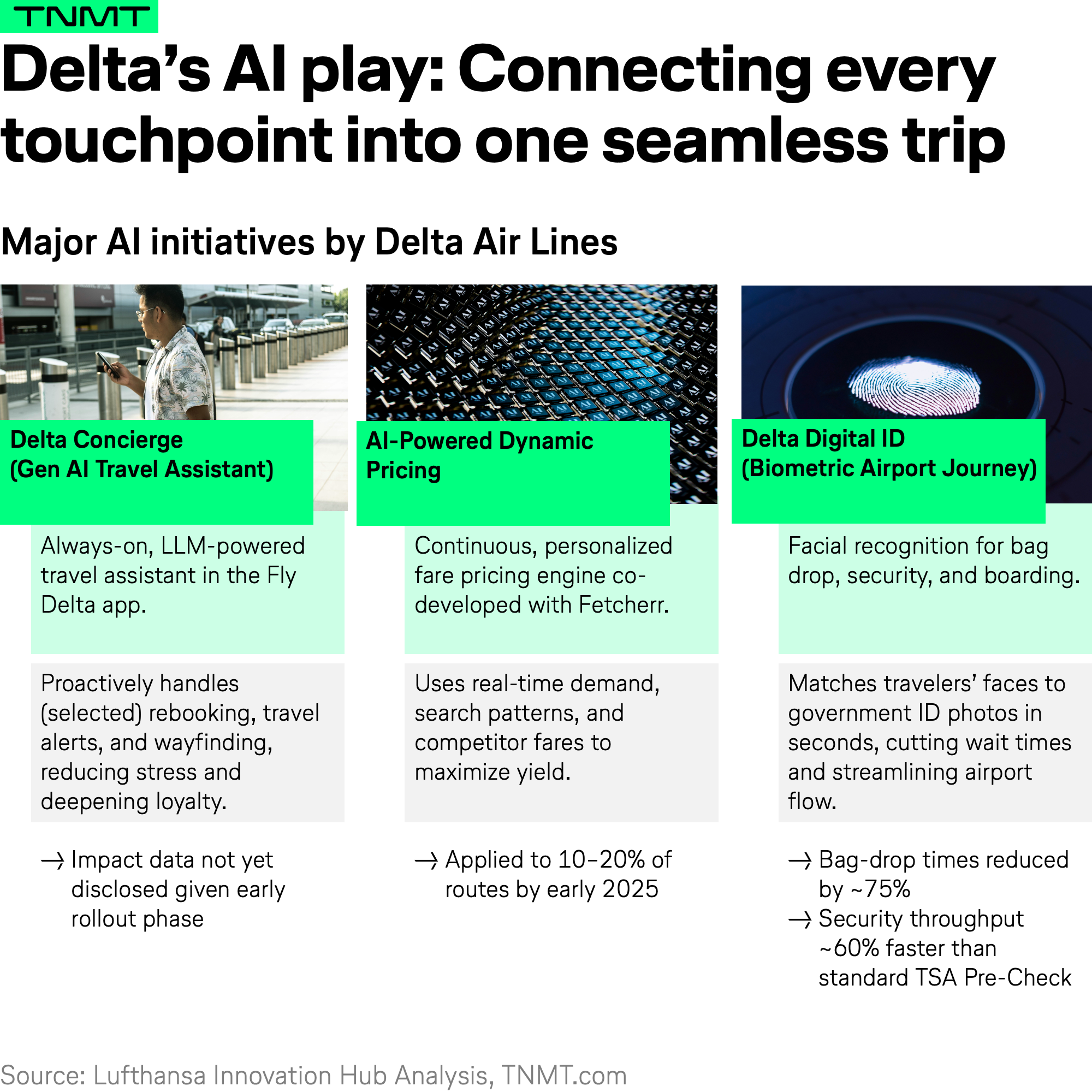
Delta Concierge
The most visible expression of Delta’s AI push is Delta Concierge, launched in early 2025 as a generative AI travel assistant inside the Fly Delta app.
- Unlike the basic chatbots of the past, Concierge is designed to anticipate traveler needs rather than just answer questions.
- It can flag passport or visa requirements before a trip, push weather and packing alerts, guide travelers through airport wayfinding (“Gate C27, 10-minute walk”), and even handle (some) disruptions by automatically rebooking flights or issuing hotel and meal vouchers.
Delta’s vision is an end-to-end orchestrator that eventually extends curb-to-gate, integrating with rideshare partners and other services along the traveler journey.
The rollout is deliberately governed with human fallback when confidence is low, but the direction is clear: a loyalty-driven, revenue-generating digital assistant for every customer.
Personalized Dynamic Pricing
Beneath the surface, Delta is also using AI to rewire its commercial model through a personalized dynamic pricing engine.
- Co-developed with Fetcherr and rolled out in 2024, the system continuously adjusts fares using a cocktail of inputs, including historical bookings and real-time demand, to competitor pricing and even browsing behavior (something that has been critically discussed in the press given data-privacy concerns).
- The aim is to move beyond static fare classes and capture each passenger’s willingness-to-pay more accurately, essentially creating a “super-analyst” that works around the clock.
- By July 2025, the engine was applied to roughly 3% of Delta’s domestic routes, with plans to expand to around 20% of the global network by the end of the year..
Early models suggest several points of RASM uplift, but the approach has also drawn regulatory attention in the U.S., where lawmakers have questioned the fairness of “personalized pricing.”
Delta maintains that fares remain market-driven and visible to all customers equally at any given time, though they now change much more frequently.
Delta Digital ID
Finally, Delta has been scaling Delta Digital ID, its biometric airport journey solution.
- Initially launched in 2021 in partnership with TSA at Atlanta and Detroit, the program has since expanded to major hubs including LAX, JFK, LaGuardia, and Salt Lake City.
- Enrolled passengers can use their faces as ID for bag drop, security, and boarding, with computer-vision systems verifying identities against government records in seconds.
The results are striking, even if they can’t be objectively assessed: bag-drop times cut by roughly 75%, security throughput 60% faster than TSA PreCheck, and adoption by a large majority of eligible travelers at participating airports.
With a nationwide curb-to-gate biometric experience planned for 2025, Delta positions itself at the forefront of a shift toward hands-free, frictionless travel.
Air Canada: Building an AI lab to fix delays
Air Canada’s AI journey looks quite different from Delta’s.
- Post-2020, when the airline faced mounting pressure to improve reliability and efficiency, leadership made a deliberate choice: AI would become an enterprise capability the company needed to own.
- That decision led to the creation of an AI Center of Expertise, which has since grown into a fully fledged in-house lab of more than 75 specialists focused almost entirely on operations.
- The mandate is clear: use AI to improve on-time performance and strengthen disruption management.
Governance has also elevated AI to a strategic capability, much like at Delta, but Air Canada’s emphasis leans heavily toward the operational backbone.
That said, customer-facing AI hasn’t been absent. The airline made headlines for a chatbot fail that ended in court after giving false refund advice – an incident that likely reinforced its decision to double down on operational AI, where the stakes are more about efficiency and punctuality than public-facing interactions.
Out of this strategy, three initiatives stand out as emblematic of Air Canada’s approach.
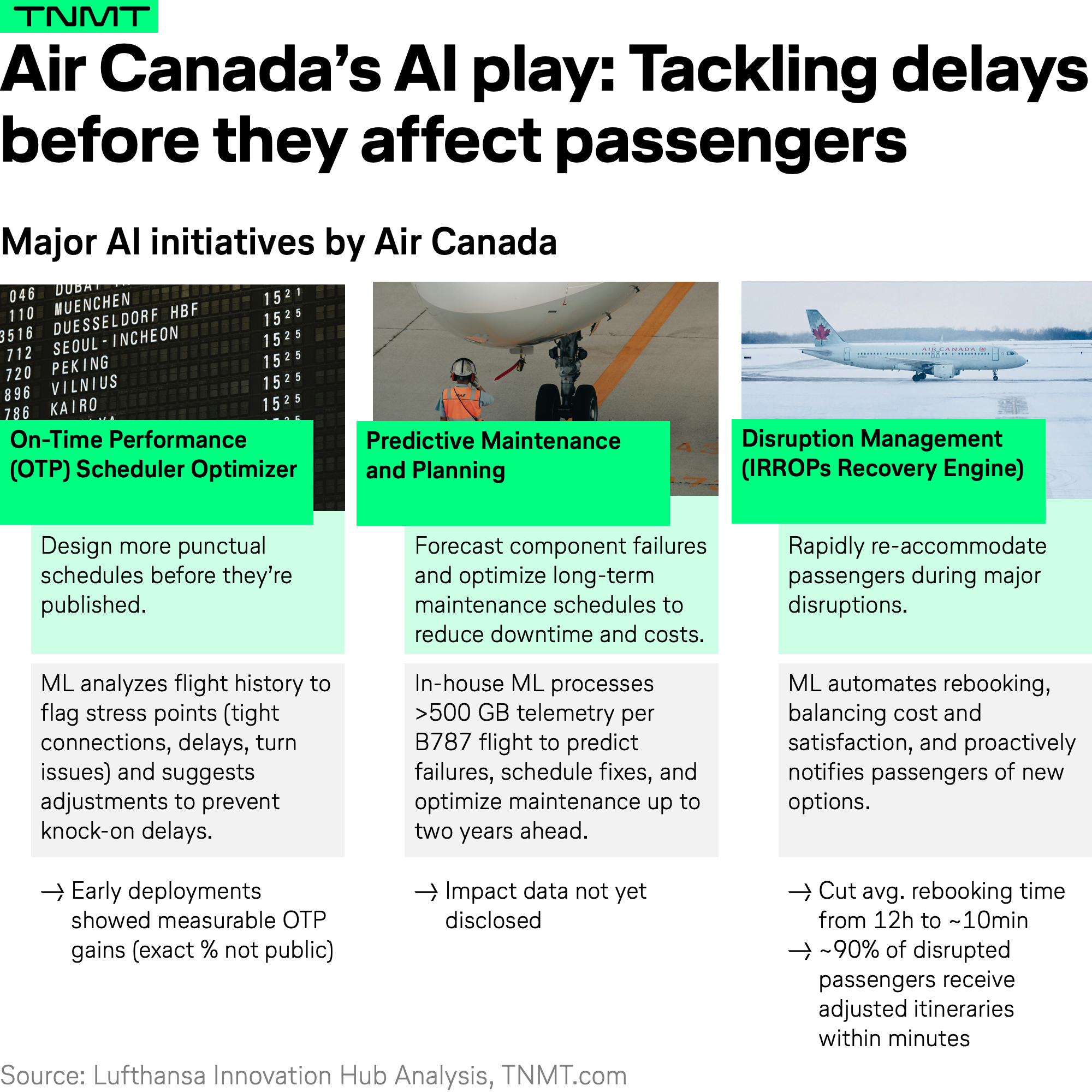
On-Time Performance Scheduler Optimizer
Air Canada developed its own OTP Scheduler Optimizer, a custom ML system designed to “immunize” flight schedules against predictable delays before they even happen.
- The tool draws on years of operational data to flag stress points such as tight connections, chronically late flights from congested airports, or problematic turn sequences.
- It then recommends pre-publish fixes, like adding 15 minutes of block time or resequencing flights, to reduce the risk of cascading delays.
- Developed fully in-house, the system is said to have delivered measurable gains, even if exact improvement rates haven’t been disclosed – a claim that aligns with Cirium data ranking Air Canada as the most punctual North American airline in June 2025, with over 77% of flights arriving on time.
Predictive Maintenance and Planning
Maintenance is one of Air Canada’s largest expenses (more than a $1 billion annual bill) and AI is increasingly central to keeping that cost under control, as reported by Future Travel Experience.
- The airline has built in-house models to forecast component failures before they happen, processing massive telemetry streams (a Boeing 787 alone generates over 500 GB of data per flight).
- These systems allow maintenance teams to swap out parts overnight instead of dealing with unexpected failures, boosting fleet availability.
- Beyond short-term fixes, AI also extends maintenance planning horizons from about 30 days to up to two years, continuously re-optimizing schedules as conditions evolve.
- That means heavy checks can be shifted into slower seasons, shop capacity balanced more evenly, and inventory optimized, thereby lowering costs while smoothing operations.
Disruption Management Engine
Finally, Air Canada has turned to automation for one of the most painful customer experiences: irregular operations.
- In 2023, the airline deployed Amadeus’ Passenger Recovery Engine, which uses ML to automate reaccommodation during cancellations and delays.
- Previously, manual rebooking could take up to 12 hours; today, the system can rebook the vast majority of disrupted passengers within minutes.
- Roughly 90% of customers now receive an optimized new itinerary automatically, including interline connections when needed.
Alaska Airlines: AI for efficiency and sustainability
If Delta is about customer touchpoints and Air Canada is about building (mostly) in-house capability, Alaska Airlines represents a third model: an operations-first mindset, closely tied to its ambition of becoming the most efficient and environmentally sustainable U.S. airline.
- To deliver on that mandate, Alaska has leaned heavily into AI for flight operations, turnaround processes, and scheduling.
- While it runs some customer-facing experiments (such as its Ask Alaska chatbot), the bulk of its AI investment is on the operational side, where efficiency gains translate directly into fuel savings and sustainability improvements.
This focus is also reflected in how Alaska approaches innovation. Instead of developing everything in-house, it has built a strong partnership model, launching a corporate venture arm, Alaska Star Ventures, to invest in startups, and partnering with external venture builders like UP.Labs (part of VC firm UP.Partners) to co-create new solutions.
Out of this strategy, three projects stand out.
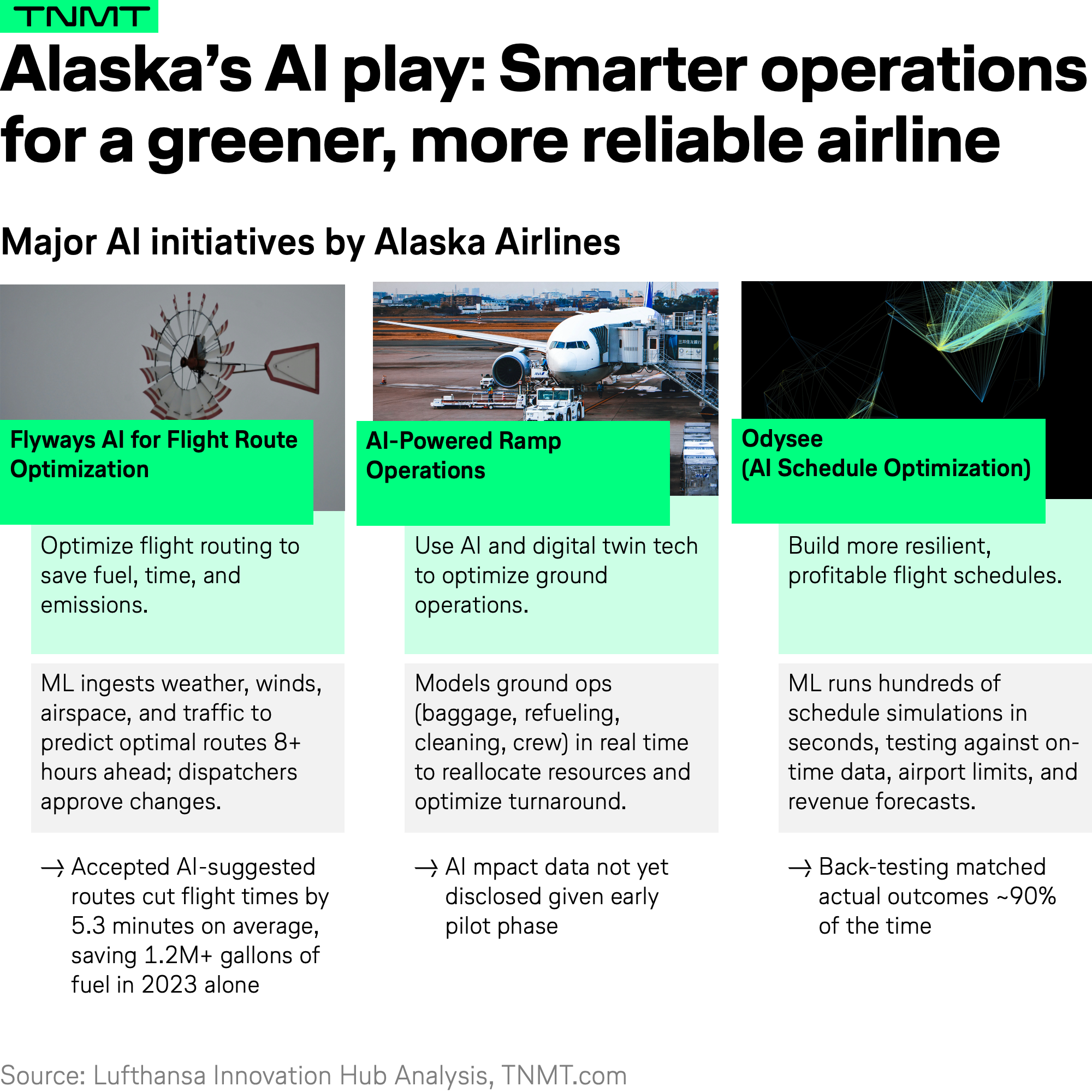
Flyways AI for Flight Route Optimization
In 2021, Alaska became the first airline to deploy Flyways AI, developed by Airspace Intelligence, into its operations center.
- The system ingests data on weather, winds, airspace, and traffic to generate predictive 4D flight maps up to eight hours in advance, giving dispatchers more accurate route options.
- In early trials, 64% of flights received AI-generated alternatives, with about a third of those accepted, saving an average of 5.3 minutes per flight.
- Within six months, the program reportedly saved 480,000 gallons of fuel and cut 4,600 tons of CO₂.
- By 2023, roughly 55% of flights included AI-optimized routing, with fuel-burn reductions of 3–5% on longer flights and more than 1.2 million gallons saved.
While the exact numbers should be taken cautiously, Alaska has called Flyways a “game-changer,” directly linked to its goal of becoming the most fuel-efficient U.S. carrier by 2025 and achieving net zero by 2040.
AI-Powered Ramp Operations
In May 2025, Alaska announced plans to deploy AI for ramp automation in partnership with Pattern Labs.
- The project uses digital twin technology to model baggage loading, refueling, cleaning, and crew positioning in real time, reallocating resources to optimize the turnaround process.
- Early pilots in Seattle reported “incredible” efficiency gains and fewer delays, though no hard metrics have been published.
- The goal is to free ground crews to focus on safety and turn quality while AI handles task sequencing and resource allocation.
- Faster turns not only improve on-time performance but also reduce unnecessary engine and auxiliary power unit (APU) idling, thereby lowering both costs and emissions.
For now, the project remains in pilot phase, but it shows Alaska’s appetite to bring AI deeper into ground operations.
Odysee: AI Schedule Optimization
Launched in late 2024, Odysee is an AI-powered scheduling tool co-developed with UP.Labs, Alaska’s venture-building partner.
- The system ingests full network schedules, historical on-time performance data, and airport constraints, then runs hundreds of simulations in seconds, a task that previously took weeks.
- Trained on more than 700,000 flight segments, Odysee stress-tests schedules to identify vulnerabilities while balancing punctuality and profitability.
- Back-testing shows roughly 90% accuracy against real-world outcomes.
Starting summer 2025, Odysee will be used to build Alaska’s schedules, with the expectation of producing more resilient operations, fewer cascading delays, and optimized deployment of aircraft on the most valuable routes.
What these strategies tell us about AI in airlines
Together, Delta, Air Canada, and Alaska illustrate just how differently airlines can approach AI.
And yet, despite these differences, their strategies reveal some common lessons for the industry.
First of all, these examples show that AI’s impact in aviation is not confined to one area of the business. The technology is starting to prove its value across very different touchpoints of the airline journey, both on the operational as well as customer side.
What stands out most is focus.
- Each of the three airlines has defined a clear conviction about where AI can make the biggest difference.
- That focus, shaped by internal capabilities and organizational belief systems, is what makes their AI initiatives tangible and measurable rather than scattered experiments.
Secondly, we also see that AI is treated as an enabler, not a replacement. Human oversight remains central, whether it’s dispatchers retaining the final say in Alaska’s Odysee project or Delta’s Concierge deferring to agents when uncertain.
This human-in-the-loop approach is key to building trust among employees and customers alike, while easing adoption in a highly regulated industry.
Finally, none of this would be possible without top-level commitment.
- In all three cases, leadership has made structural governance changes that embed AI as a strategic capability rather than a side project.
- Board committees, cross-functional governance bodies, and dedicated in-house labs ensure that AI is scaled responsibly.
How does this align with your own AI efforts? What’s holding back launches inside your airline, and what are your biggest takeaways from these cases?
We’d love to hear your perspective.


